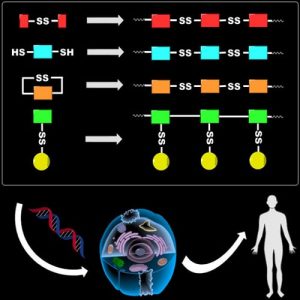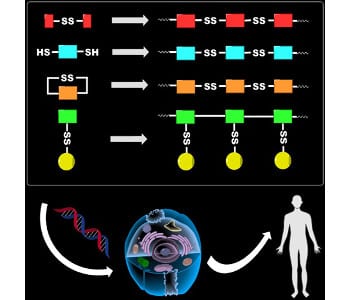 Biodegradable polymers have been successfully used in an array of biomedical applications ranging from surgical sutures, coatings of implantable devices, and sophisticated drug delivery systems. Most of the existing clinical applications of biodegradable polymers make use of hydrolytically degradable polymers such as polyesters and polyanhydrides.
Biodegradable polymers have been successfully used in an array of biomedical applications ranging from surgical sutures, coatings of implantable devices, and sophisticated drug delivery systems. Most of the existing clinical applications of biodegradable polymers make use of hydrolytically degradable polymers such as polyesters and polyanhydrides.
An alternative class of biodegradable polymers that degrade by reduction of disulfide bonds has received growing attention with recent advances in genomics and nanomedicine. In particular, bioreducible cationic polymers are being developed for applications in delivery of a broad range of therapeutic nucleic acids that can be used as a novel category of drugs in the treatment of multiple diseases. Bioreducible polycations can bind negatively charged nucleic acids and self-assemble into nanosized polyelectrolyte complexes. The complexes protect the nucleic acids from degradation in enzyme-rich biological environment and facilitate transport to the sites of therapeutic action of the nucleic acids. Due to the unique dynamic nature of the disulfide bond and favorable distribution of disulfide reducing microenvironment in the organism and cells, bioreducible polycations permit selective delivery and release of therapeutic nucleic acids in the most appropriate intracellular locations. Such selectivity is possible because high disulfide reducing capacity in biological environment for the most part coincides with the locations in which the release of therapeutic nucleic acids is desirable.
David Oupicky and Jing Li (University of Nebraska, USA) now survey recent advances in the synthetic methods of bioreducible polycations and analyze the current status of the knowledge of how bioreducible polycations interact with living systems and deliver nucleic acids in multiple disease states, including cancer and cardiovascular disorders.

















